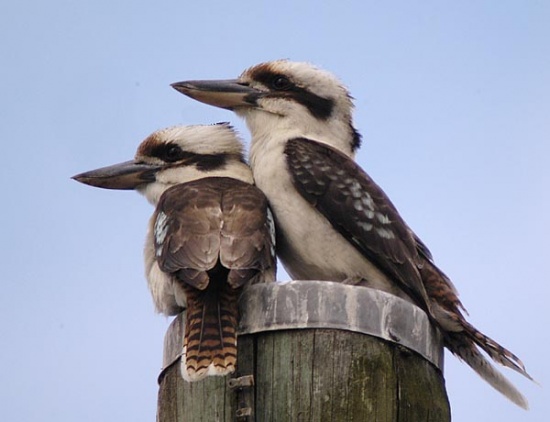(Video link. Flight picture. References updated) |
(Imp sizes. References updated) |
||
| Line 3: | Line 3: | ||
''Dacelo gigas'' | ''Dacelo gigas'' | ||
==Identification== | ==Identification== | ||
| − | + | 39–42 cm (15¼-16½ in) | |
*Off-white below with faint dark brown barring | *Off-white below with faint dark brown barring | ||
*Brown on back and wings | *Brown on back and wings | ||
| Line 35: | Line 35: | ||
'''Song''': ''koo-koo-koo-koo-koo-kaa-kaa-kaa'' | '''Song''': ''koo-koo-koo-koo-koo-kaa-kaa-kaa'' | ||
==References== | ==References== | ||
| − | #{{Ref- | + | #{{Ref-Clements6thAug15}}#Trek Nature |
{{Ref}} | {{Ref}} | ||
==External Links== | ==External Links== | ||
Revision as of 21:05, 4 May 2016
- Dacelo novaeguineae
Dacelo gigas
Identification
39–42 cm (15¼-16½ in)
- Off-white below with faint dark brown barring
- Brown on back and wings
- Rufous tail, broadly barred with black
- Dark brown eye-stripe
- Mottled blue on wings
Massive bill is 5-6 cm long.
Sexes similar
Distribution
Eastern Australia. Woodlands and open forest, Cape York Peninsula to Eyre Peninsula. Introduced and established in Tasmania and south-western Western Australia.
Taxonomy
Largest member of the kingfisher family Alcedinidae.
Subspecies
There are two subspecies[1]:
- D. n. minor:
- North-eastern Australia (Cape York Peninsula south to Cooktown)
- D. n. novaeguineae:
Habitat
Open forests and woodlands.
Behaviour
Diet
Includes insects, worms and crustaceans, small snakes, mammals, frogs and birds. Small food items are eaten whole, but larger prey is first killed by striking it against a hard surface.
Breeding
The nest is a bare chamber in a tree hollow or in a burrow excavated in a termite mound. Both sexes incubate the eggs and care for the young.
Vocalisation
Song: koo-koo-koo-koo-koo-kaa-kaa-kaa
References
- Clements, J. F., T. S. Schulenberg, M. J. Iliff, D. Roberson, T. A. Fredericks, B. L. Sullivan, and C. L. Wood. 2015. The eBird/Clements checklist of birds of the world: v2015, with updates to August 2015. Downloaded from http://www.birds.cornell.edu/clementschecklist/download/
- Trek Nature
Recommended Citation
- BirdForum Opus contributors. (2024) Laughing Kookaburra. In: BirdForum, the forum for wild birds and birding. Retrieved 26 April 2024 from https://www.birdforum.net/opus/Laughing_Kookaburra
External Links





